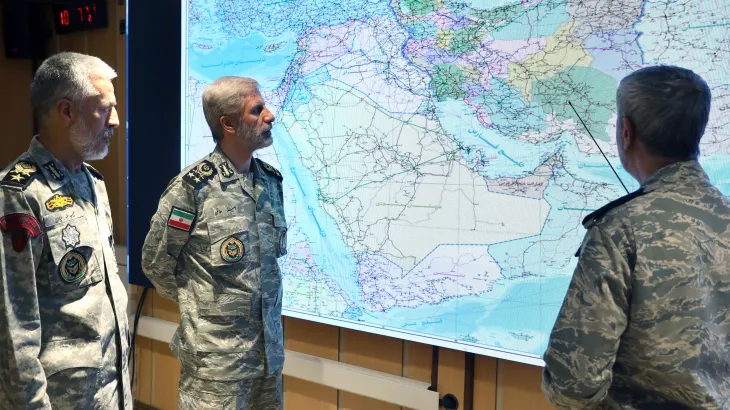
Wafric News – June 23, 2025
Tehran, Iran - Tensions in the Middle East are escalating rapidly as Iran vows a forceful response to U.S. airstrikes on its nuclear facilities, while intensifying its retaliatory campaign against Israel with a barrage of drones and missiles.
On Monday, Iran’s military command confirmed it had launched dozens of explosive-laden drones targeting Israeli positions, following what it described as “direct American aggression” against critical nuclear infrastructure in Fordow, Natanz, and Isfahan.
Speaking from Gilan, newly appointed Chief of Staff of Iran’s armed forces, Gen. Abdolrahim Mousavi, accused the U.S. of crossing a red line. “Washington has openly entered this war. Its forces and interests are now legitimate targets of Iran’s military response,” he declared. Mousavi described Israel as an “illegitimate and aggressive offspring” and warned the Islamic Republic would not back down.
In a fiery televised statement, Iranian military spokesperson Ebrahim Zolfaghari suggested the U.S. strikes were designed to prop up what he called a “crumbling Zionist regime.” He warned that American involvement would only broaden Iran’s scope of targets and increase the possibility of a regional conflagration.
Addressing U.S. President Donald Trump directly, Zolfaghari said in English: “Gambler Trump, you may start this war, but we will be the ones to finish it.”
Missile Storms and Retaliation
Air raid sirens echoed through Israeli cities on Monday as Iranian drones and missiles struck regions including Ashdod and Lachish. Iran claims a majority of its projectiles reached their targets.
In turn, Israel intensified its aerial campaign deep inside Iranian territory, with strikes reported on multiple civilian and military installations in Tehran, Karaj, and Kermanshah. Among the reported targets were the Mehrabad airport in the capital, underground military facilities, and missile depots. The Iranian government said the Fordow nuclear facility was struck again later in the day, though no actor has claimed responsibility for the second strike.
Tehran also confirmed that critical infrastructure was hit, including the Evin Prison entrance, a Red Crescent facility, and Shahid Beheshti University. The attack temporarily disrupted state TV broadcasts.
Casualties and Fallout
Iran’s Health Ministry reported over 400 people — mostly civilians — have died in the Israeli bombardments since the renewed exchange began. Israeli sources put their own casualties at 24, attributed to Iranian drone and missile attacks.
Meanwhile, fallout from the U.S. strikes has fueled debate within Iran’s political circles. Lawmakers are calling for Tehran’s withdrawal from the nuclear Non-Proliferation Treaty (NPT) and a freeze in cooperation with the International Atomic Energy Agency (IAEA). The final decision will rest with Iran’s Supreme National Security Council.
Tehran has also raised the specter of closing the Strait of Hormuz — a critical chokepoint for global oil shipments — if hostilities escalate further.
Global Reactions and Diplomatic Maneuvering
Iran’s Foreign Minister Abbas Araghchi met with Russian President Vladimir Putin in Moscow on Monday, seeking diplomatic support. Araghchi welcomed the Kremlin’s condemnation of the U.S. attacks and called for concrete action at the United Nations Security Council.
UN Secretary-General António Guterres, addressing the UNSC in an emergency session, called for an immediate end to hostilities, warning of a “grave escalation” across the Middle East.
Simultaneously, the IAEA’s Board of Governors convened an exceptional meeting in response to the strikes on Iranian nuclear sites, while EU leaders gathered in Brussels to weigh their response to the widening crises in Iran and Gaza.
Media and Messaging
Iranian media, both conservative and reformist, responded with defiance. The hardline Keyhan newspaper hailed the missile barrage, writing, “Iranian Kheibar Shekans set Israel ablaze.” Reformist daily Ham-Mihan featured a demonic image of Donald Trump under the headline “Bullying Diplomacy,” while Shargh published a somber cover story titled “Hello World, We Are Here,” drawing global attention to the civilian toll.
Outlook
The regional landscape remains precarious. With threats from Yemen’s Houthis to resume maritime attacks and the potential for U.S. bases across the region to come under fire, the Middle East teeters on the edge of a broader war.
WafricNews will continue to monitor the situation as diplomatic channels are tested and military confrontations intensify.
By WafricNews Desk.
By WafricNews Desk.


Comment
To post a comment, you have to login first
LoginNo Comments Yet...